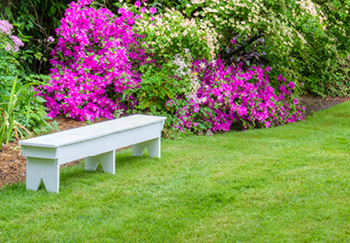Growing and Caring for Azaleas
November 14th, 2023 | Categories
Azaleas are perennial flowering shrubs in the same family as Rhododendrons for their shared characteristics. Azaleas, like rhododendrons, are very popular being found in many a British garden. The reason: they are a gorgeous plant with lots of interest! Most are evergreen with dainty leaves, giving interest all year round, though some are deciduous. Azaleas have lovely small flowers in a variety of colours depending on the type, from reds, pinks, purples, oranges, and yellows, with some even having two coloured flowers, and the flowers tend to cover the entire plant too, which makes for a really stunning display! On top of that, they have a fantastic fragrance, bringing another layer of interest to the garden. Azaleas can grow to heights of 20 feet or more, though there are many dwarf varieties that look just as stunning that grow to about 3 feet.
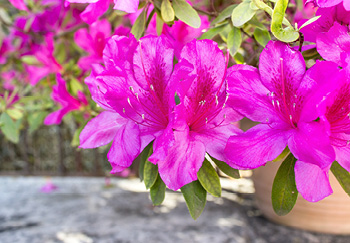
Azalea Factsheet
- Plant type: Shrub, evergreen, deciduous
- Flower colours: Pinks, purples, reds, oranges, yellows, white
- Flowers: Late winter to spring
- Prune in: Spring after blooming
- Sun exposure: Prefers partial or dappled shade ideally
- Hardiness: Hardy
- Soil type: Well drained, acidic soil
- Wildlife: Bees like it
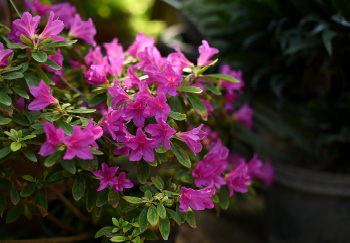
Differences with Azaleas & Rhododendrons
As mentioned, azaleas and rhododendrons are grouped together in the same family because of their shared characteristics, however there are differences to know between them:
- There are differences in leaves. An azalea’s leaves are thin and small, in contrast to rhododendron leaves which are considerably larger and thicker.
- Azaleas flowers are small and dainty, while rhododendrons are larger. An azalea usually develops many more flowers by comparison too, often appearing covered in blooms while rhododendrons will form larger flowers at the end of a stem.
- Azaleas have more stems than rhododendrons, giving them more of a bushier look.
While there are differences, we don’t consider one necessarily better than the other. Azaleas and rhododendrons look wonderful together and their near identical needs make them excellent companions.
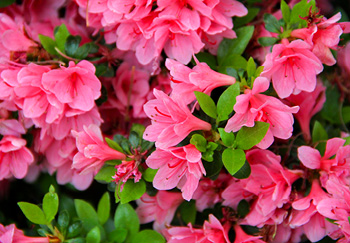
Types of Azaleas
Some azaleas we love and are very popular are:
- Anne Frank
- Geisha Orange
- Rani
- Johanna
- Corany
- Northern Hi-lights
- Chanel
- Klondyke
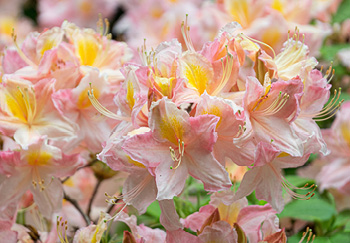
How to Grow Azaleas
An azalea shrub in full bloom is a beautiful sight. Thankfully, these shrubs are easy to care for with just a little initial effort. They’re quite versatile and hardy plants being tolerant of many different light, temperature, and soil conditions, though they do need a more acidic soil. They tend to do well in most places in the UK. Whatever growing conditions you have, this guide will walk you through some key information to help your plant thrive and give you wonderful displays for years to come.
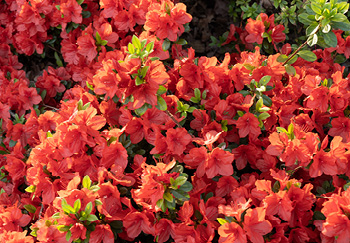
Specific Needs to Look Its Best
Azaleas prefer acidic soil which can be easily achieved by using ericaceous compost, which is specifically designed for acid-loving plants like azaleas. Additionally, there are many other ways to introduce acidity to compost or soil over by introducing organic matter like well-rotted manure, wood chips, leaf mould and pine needles. Specifically made products are also available that can help such as a slow-release acidic pellet fertiliser, or acidic liquid concentrate fertiliser that gives a quick boost.
If your aim is to plant in a pot, fill it with ericaceous compost in the first year, then top up the acidity and nutrients in the coming years with these methods. If planting in the ground, each spring mulch around the base with a good amount of organic matter or gently dig in some of the pellets. It will also benefit from an appropriate liquid feed now and again through the growing season.
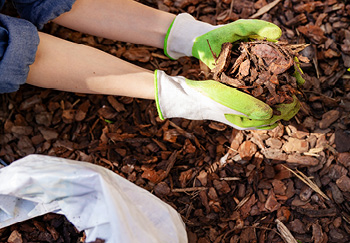
Where to Plant
Azaleas don’t like to be in the open exposed to cold harsh winds, so a good, sheltered spot is best in the garden, such as amongst other plants, against a fence, or in a corner. It likes partial shade, and is even tolerant of shadier conditions, but does require at least some sun throughout the day to really look its best. They don’t tend to do as well in full sun as they would in partial shade. More thought will be required if planting in the ground than in a pot, which can easily be moved at points to allow it both shelter and sun. Be sure to plant in a spot that is well draining as they don’t like to be waterlogged and can die from being overwatered. To help keep potted azaleas free from waterlogging you can add something like perlite or potting grit to the compost mix.
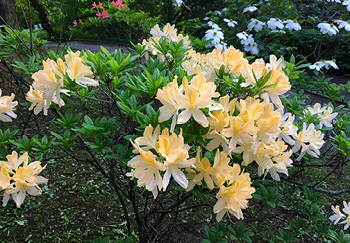
How to Plant
Whether planting in the ground or in a pot, azaleas shouldn’t be planted too deeply due to their shallow root system. If they are they will struggle to flower. Aim to dig a hole that that the roots are just beneath the soil surface by a few inches at most.
A further tip when planting in the ground is to dig a hole about twice the size of what you need, and when planting in-fill with ericaceous compost and other organic material. This will give it plenty of nearby nutrients to seek out. Tease the roots out a bit to encourage them to seek out nutrients when planted.
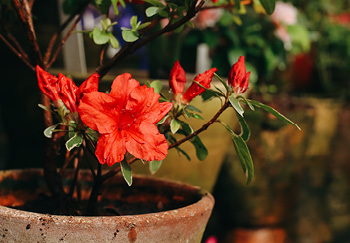
When to Plant
We think the best time to plant is in autumn, when the ground is still warm from the summer sun, but there’s more moisture from the autumn rains. Planting in autumn is preferred instead of spring and summer also because at these times the plant is coping with being transplanted, and trying to grow, which can cause a bit of shock and other problems. Also, its roots would not be as developed to cope during periods of drought.
If you can’t wait until autumn or have missed the boat, then aim to plant as early as possible in the spring following the last frosts.
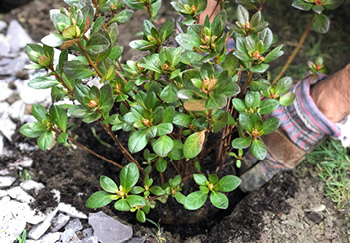
Ongoing Care
Azaleas are fairly low maintenance overall. They will benefit from a mulch of or ericaceous compost or any organic material mentioned earlier added around the base of the plant annually in spring. This will help to provide nutrients and keep the nearby soil acidic. A liquid feed of an appropriate fertiliser will also benefit it now and again through the growing season. They are quite hardy even to frosts but like any plant they will benefit from some protection like with a horticultural fleece.
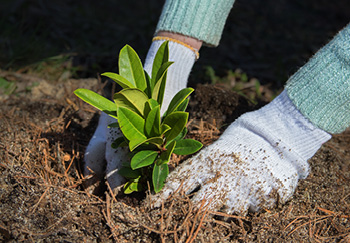
Pruning
As for pruning, there is usually very little need to prune if at all, however, deadheading blooms after flowering will improve the appearance. Some gardeners do take a proactive approach to pruning to get their azaleas flowering as much as possible. Azaleas flower on stems grown the previous year and set new buds for the following year by August latest usually. So, what to do is, after the blooms fade and die off, you can trim the stems back. This will encourage them to grow more stems where buds will set to ensure some great flowering the following year. Having said that, they tend to still look great with minimal pruning.
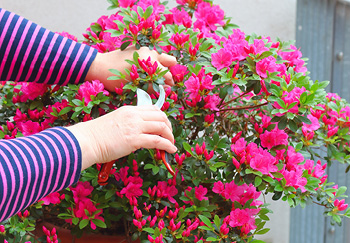
Companion Plant Ideas for Azaleas
A group of azaleas together in different colours looks with their near full coverage blooms and will smell fantastic too. But, if you would like to include it amongst a variety of plants in a bed or border, then some companion plants we recommend with similar requirements are:
- Camellias
- Pieris
- Hydrangeas
- Bleeding Hearts
- Berberis
- Mahonia
- Viburnum
- Rhododendrons
Azaleas are woodland plants, so they also look good when underplanted with plants like:
- Hostas
- Ferns
- Hellebores
- Heathers
- Astilbe
Planting with height, position, and flowering time in mind can help you create a full looking cornucopia of woodland plants for interest throughout the spring and summer. It would be just lovely.
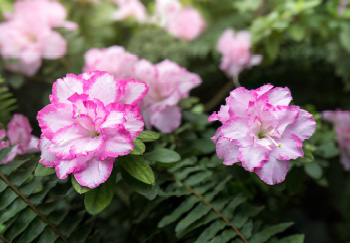
Have Beautiful Azaleas in Your Garden
Azaleas are beautiful plants than can add much interest to any garden. With their many beautiful flower colours there’s a favourite for everyone. The great part is they are low maintenance so a perfect choice for someone who wants a nice garden but doesn’t have too much time to always go back to it. Why not visit our garden centres or shop online to see our range today?
